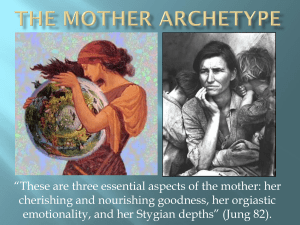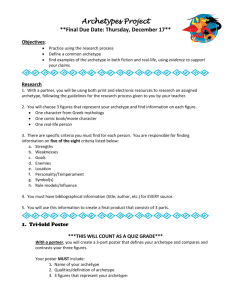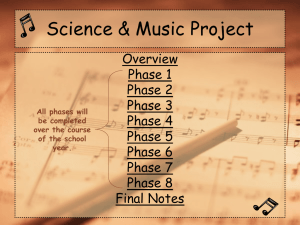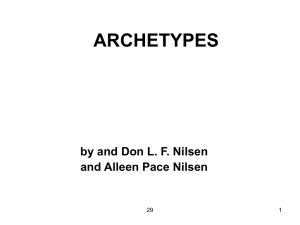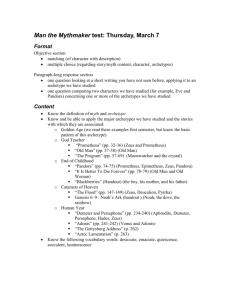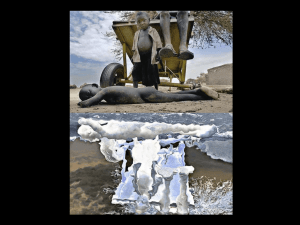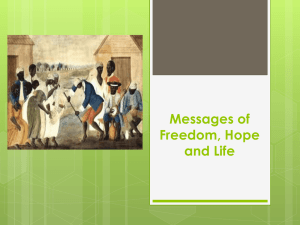The Father Archetype: Exploring Myths, Literature, and Modern Examples
advertisement
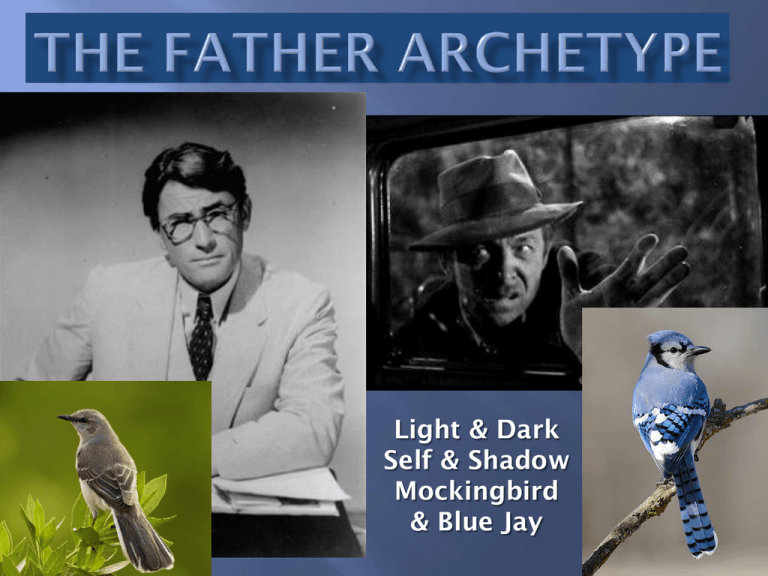
Light & Dark Self & Shadow Mockingbird & Blue Jay “In myth, legend and dreams, the father archetype personifies as the Elder, the King, the Father in Heaven. He is the living embodiment of the Logos principle: his word is law. As Defender of the Faith and of the Realm he is the guardian of the status quo and bastion against all enemies. His attributes are activity and penetration, differentiation and judgment, fecundity and destruction” ("Transforming the Mind: The Father“). “Without the father there is chaos, conflict, and sadness…when we feel the confusion of a fatherless life and wonder where he could be, the father has been evoked…he is finding his way back” (Moore 34). “A father is one whose perspective and knowledge are rooted in the underworld and tied to the forefathers, those who have gone before and have created the culture that the father now takes into his hands. A father’s wisdom and moral sensibility find their direction from voices that are not now in life. His initiators are both those literal fathers who have created culture and his own deepest reflections” (Moore 36). “In dreams, it is always the father-figure from whom the decisive convictions, prohibitions, and wise counsels emanate…an authoritative voice which passes final judgments” (Jung 214 – 215). “It is the figure of a ‘wise old man’ who symbolizes the spiritual factor…The wise old man appears in dreams in the guise of a magician, doctor, priest, teacher, professor, grandfather, or any other person possessing authority” (Jung 216 - 217). In multiple patriarchal mythologies and various world religions, the ruling deity is a father figure who routinely dwells in the heavens: Uranus/Caelus and Zeus/Jupiter from Greek/Roman mythology, Odin from Norse mythology, Amon Ra from Egyptian mythology, the father/sky gods of various African tribes, God the Father of Christianity, Yahweh of the Jewish faith, and Brahma from the Hindu religion. The Father archetype can extend to the son in a positive manner (evident in numerous religious systems such as the loving relationship between the Christian God and Christ the Son) But there is a darker side of the Father, sometimes negatively stretching out toward his children (active in the disturbing Greek myth concerning Cronus and his attempt to devour Zeus). The Father Archetype has a distinct relationship with both the Shadow and the Child. As a father figure, the Father must first be aware of the Shadow in order to effectively (and momentarily) shield their young charges from internal and external harm. But the Father must also eventually initiate the Child into the darker ways of the world, helping them begin to know the Shadow within and without, removing their protective parental barriers. When seeking out the presence of the Father archetype within literary works, heed the movements of any character that exudes a definite sense of command or control. Additionally take note of figures who provide invaluable direction or sagacious advice to other pivotal characters. One final hint is to explore the deeper implications of one generation’s generosity toward the members of the next generation. If the metaphysical gifts and insights imparted are substantial, even if given to characters not directly related to the figure(s) in question, this might indicate the Father archetype is present within the examined text. Cover illustration for the 1995 edition of Steinbeck’s To a God Unknown. In John Steinbeck’s unsettling work To a God Unknown, the protagonist’s father passes away but his spirit inhabits a tree near his son’s settlement, “He heard the sounds come back to the land…and the great tree stirred to life under the wind. Joseph raised his head and looked at its old, wrinkled limbs. His eyes lighted with recognition and welcome, for his father’s strong and simple being…had entered the tree” (Steinbeck 18). Later in the strange text, Joseph rises up to the status of the Father, lording over his land, “That authority passed to Joseph. He spoke with the sanction of the grass, the soil, the beasts wild and domesticated; he was [now] the father of the farm” (Steinbeck 24). Modern Examples of the Father’s Presence In the Beach Boy’s song “Child Is Father of the Man”, Brian Wilson explores the eternal cycle of the son’s journey through childhood (under the tutelage of a guiding father’s hand) toward his ultimate destination – maturity and the claiming of the status of fatherhood as he begins guiding his own offspring on their life’s journey. In simple terms, the songwriter describes this complicated circle, “(The child) father of the man…Easy my child, it's just enough to believe…Out of the wild into what you can't conceive / You'll change” (Wilson). Harry Chapin’s song “Cats in the Cradle” is a perfect example of the Father’s absence and its ramifications explored in song. After detailing the various ways in which he himself was an aloof father during his child’s early years, at the end of the folk song the father realizes that his own son’s lack of affection toward his aging father is a reflection on his own lackluster parenting, “I've long since retired, my son's moved away / I called him up just the other day /I said, ‘I'd like to see you if you don't mind’ / He said, ‘I'd love to, Dad, if I can find the time’…He'd grown up just like me / My boy was just like me” (Chapin). In George Lucus’ Star Wars Darth Vader is superficially and primarily the epitomy of the dark side of the Father. Enveloped in the cloud of the Dark Side of the Force, the remaining human shred of Anakin Skywalker must struggle with his Shadow and the Emperor to eventually sacrifice himself to save the life of his son. With his son’s help, he takes off the mask of Darth Vader. http://www.youtube.com/watch?v=RwjOMVPMnxU In Walt Disney’s The Lion King, young Simba is guided by his father both in life and death. Despite his early demise, Mufasa manages to still provide needed instruction to his son as he struggles to mature and face down the enemies of the jungle kingdom. http://www.youtube.com/watch?v=PZfeR-QE5io In both the book and film series, although not related by blood Dumbledore definitely acts as a guide and father figure to young Harry Potter. Whether offering advice, providing magical gifts of assistance, or sacrificing his life to indirectly protect Harry’s life, Dumbledore exemplifies the Father archetype. http://www.youtube.com/watch?v=UunqBAHBDo8 Gandalf from Lord of the Rings is a prime example of the Father archetype as guide. As Frodo and the other halflings make their treacherous ways to move against the darkness, the wizard provides sagely words of wisdom, offers his powerful protection, and even faces and returns from death to defend them in their quest. http://www.youtube.com/watch?v=44kBN340vd4 o Chapin, Harry. "Cats In The Cradle Lyrics." Lyrics Depot - Free Song Lyrics. Web. 2 Oct. 2011. <http://www.lyricsdepot.com>. o Jung, C. G. The Archetypes and the Collective Unconscious. 2nd ed. New York: Princeton University Press, 1959. Print. o Moore, Thomas. Care of the Soul: A Guide for Cultivating Depth and Sacredness in Everyday Life. Harper Collins, 1992. Print. o Steinbeck, John. To a God Unknown. New York: Penguin Books, 1925. Print. o "Transforming the Mind: The Father." Trans4mind. Trans4mind, Web. 26 Oct 2009. <http://www.trans4mind.com>. o Wilson, Brian. "Child Is Father Of The Man" Lyrics Depot - Free Song Lyrics. Web. 6 Oct. 2010. <http://www.lyricsdepot.com>.
